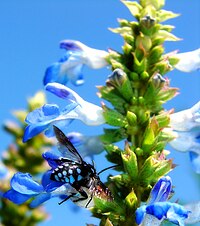Salvia uliginosa
| Salvia uliginosa subsp. var. | Bog sage | |||||||||||||||||||||||||||||||||||||||||||||||||||||||
|---|---|---|---|---|---|---|---|---|---|---|---|---|---|---|---|---|---|---|---|---|---|---|---|---|---|---|---|---|---|---|---|---|---|---|---|---|---|---|---|---|---|---|---|---|---|---|---|---|---|---|---|---|---|---|---|---|

|
|
| ||||||||||||||||||||||||||||||||||||||||||||||||||||||
| ||||||||||||||||||||||||||||||||||||||||||||||||||||||||
Salvia uliginosa (Bog sage) is a herbaceous perennial native to southern Brazil, Uruguay, and Argentina. It was described and named by botanist George Bentham for its typical habitat "of swamps and marshes", or "uliginosa". It was introduced into horticulture in 1912, and has become popular for its azure-blue flowers and ability to grow under various conditions.[1]
Salvia uliginosa grows up to 3 to 6 ft tall in one season, with multiple thin stems and yellow-green lance-shaped leaves that have serrated edges. The plant quickly spreads on underground runners and is readily divided. The bright azure-blue flowers are .5 in cm long with a white beeline in the throat pointing toward the nectar and pollen. They grow in whorls beginning in summer until fall, with many flowers coming into bloom at the same time. The plant is a favorite of Beth Chatto for its extreme winter hardiness (to 15 °F °C or lower) in the Beth Chatto Gardens.[1]
| Standard Cyclopedia of Horticulture |
|---|
|
Salvia uliginosa, Benth. Sts. herbaceous, erect, 2-6 ft. high, virgate, branched, glabrous or villous: lvs. 2-4 in. long, petiolate, oblong-lanceolate, acute, serrate, base narrowed, glabrous or pubescent; floral lvs. membranaceous, broad-ovate, acuminate, deciduous: racemes dense, long-peduncled, somewhat branched; floral whorls many-fld.; calyx campanulate, variable, sometimes colored; corolla blue or white, tube somewhat or nearly included. Brazil, Argentina, and Uruguay. CH
|
Cultivation
Propagation
Pests and diseases
Varieties
Gallery
References
- ↑ 1.0 1.1 Clebsch, Betsy; Carol D. Barner (2003). The New Book of Salvias. Timber Press. p. 295. ISBN 9780881925609. http://books.google.com/books?id=NM0iwB8GrQYC&pg=PA295.
- Standard Cyclopedia of Horticulture, by L. H. Bailey, MacMillan Co., 1963
External links
- w:Salvia uliginosa. Some of the material on this page may be from Wikipedia, under the Creative Commons license.
- Salvia uliginosa QR Code (Size 50, 100, 200, 500)
